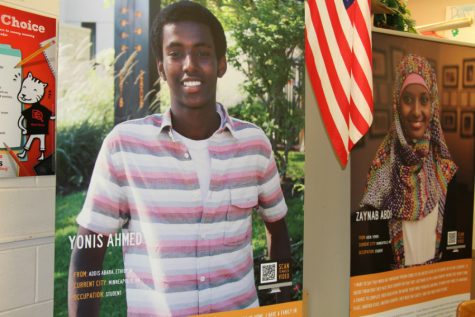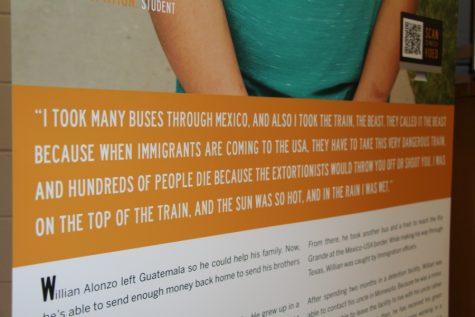Green Card Voices brings immigrant student stories to light
January 10, 2017

Before winter break, you may have noticed that there were signs posted around the building with pictures and quotes from student immigrants. Who are the students? Why were they interviewed? And what is the intended outcome of the project?
The organization behind the making of the signs is a nonprofit called Green Card Voices. Their goal is to help share the personal stories and experiences of immigrants with the hope of challenging stereotypes, and help to build bridges of understanding and connection between immigrants and nonimmigrants.
As said by the executive director of the program, Tea Rozman-Clark, “We really want [Green Card Voices] to be an educational resource for as many people as possible to learn about immigrant stories, and immigrants themselves.”
Rozman-Clark herself is an immigrant. “I was born in a country called Yugoslavia, and when I was 15 we had war… I came here when I was 20 as a foreign exchange student, and then I went back and came back to the states as a grad school student, and then went back again and finally moved here 4 years ago.”
The students featured on the signs were all interviewed at Wellstone International High School in Minneapolis last year. One of them, Yonis Ahmed, transferred to South this year. He came from Addis Ababa, Ethiopia, in 2015, and was reunited with much of his family in Minneapolis. However, he had to leave all his siblings behind because they were too old to get their visas. “I came here by myself and didn’t speak English… it was difficult,” he said. “But I am happy here… now I go here as a student and am learning English.”
Ahmed remembered being asked by a friend to participate in the interviews at Wellstone, and was happy to do it: “The reason I did this is so [people can see] that someone who is new to the country or doesn’t speak English… [isn’t] scary. In Minnesota there are a lot of immigrants… a lot of people come here and don’t speak English… maybe they’ll hear my story and [be inspired].” Smiling, he went on to say “[Now] I go to many events… they asked me to make a speech on [my experience]… what it’s like to be in a new country.”

After the students’ stories were recorded and shared as videos on the Green Card Voices website, the signs were made and displayed at South. The stories were used to create a book, “Green Card Voices,” that can currently be found in South’s media center.
Though they have accomplished a lot so far, Green Card Voices only started four years ago in 2013. Rozman-Clark explained how it was inspired by a book called Green Card Stories written by Laura Danielson, an immigration lawyer in the Twin Cities. “The concept [of the organization] was native with Ali Alizadeh who is an immigrant living here in Minneapolis… she’s a well established entrepreneur, and she really wanted to support this project further beyond the book, at the time I was… [learning] about… digital humanities… [which is] all about first person storytelling and the power of… people telling their own stories. So all of us together thought it would be great to continue with a non profit organization, and in 2013 the organization was formed.”
More recently, Green Card Voices has expanded their program with projects like the Wellstone project. They are also working on a project interviewing people in Fargo, Minnesota, and will be publishing a book called “Immigrants Coming from 22 Countries.” In addition, they will be interviewing students at another international high school in St. Paul, and will be publishing a book with those students’ stories.
The Green Card Voices displays were brought to South by English teacher Nicole Schneider. “I received an email from [Rozman-Clark], and she offered… I thought it would be a good opportunity to bring the displays to South and [maybe] expand people’s minds.”
Though the signs were recently taken down, they still seem to have made a difference. “I [saw] a lot of kids looking at the stories and reading them, and a lot of kids have checked out the books,” said Debra Snell, who works in the media center. “It’s a great way for us to understand stories that are different than our own.”
As Schneider said, “I think it’s good to get these stories out because a lot of times people are oblivious to what immigrants really have to go through… I would think that anytime they have this displayed it creates a better light… to inform [and educate] people, which helps especially with the election and where we’re going [right now] in society.”
Rozman-Clark explained that she felt that: “The need for work has increased… with the demographic shift and the backlash that that has received, there is a great need for people to better understand who their new neighbors are, and to encourage fostering that tolerance, acceptance and empathy.”
She hopes that Green Card Voices will be able to expand their program even further, “especially in the regions where there’s an increase in immigration but the climate is quite negative towards immigrants. [Currently] we… have 230 stories recorded, [but] we would love to have thousands, we would love to [record stories] throughout the United States and perhaps other countries that are seeing challenges with immigration as well.”
Mahmood Mohiuddin • Mar 14, 2017 at 10:44 pm
Would. Like to record some personal experience s of our time in States. Please advise.